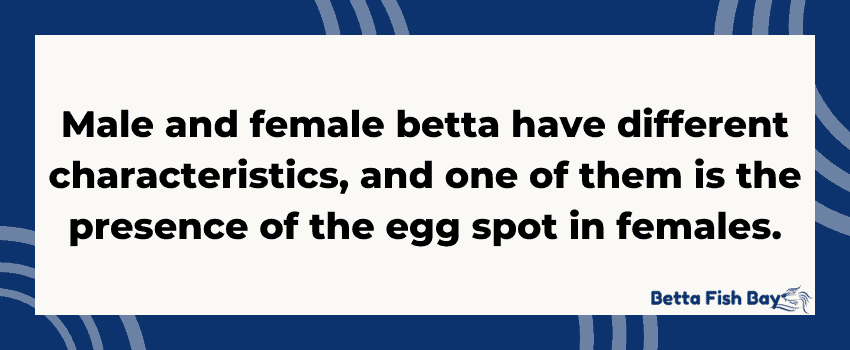Are you an aspiring betta breeder? Or have you noticed a white spot on your betta and wondered what it is?
The betta egg spot is an essential component of female betta anatomy. It serves to carry and lay eggs for reproductive purposes.
Some betta owners are perplexed when they discover an “egg spot” on their male betta. This may happen due to stress, poor tank conditions, or aggressive tank mates.
The betta egg spot, also called the ovipositor spot, is a part of the sexually mature female betta’s anatomy. It is a small white spot on the betta’s belly, located between the ventral and anal fins. The purpose of the betta egg spot is to carry eggs and lay them after mating.

Table of Contents
What are betta fish egg spots?
You will not be able to see the betta egg spot until the female betta has reached sexual maturity. This usually occurs at around 16 weeks.
Look near the betta’s head between the ventral and anal fins to locate the betta egg spot. There should be a tiny white dot there, which is the egg spot.
Do male betta fish have egg spots?
The ovipositor spot is not a part of the male betta anatomy.
However, male bettas can sometimes develop a false egg spot. This will look identical to the egg spot on female bettas but is not permanent.
Male betta fish develop a false egg spot when they feel threatened. This will most likely occur if the betta lives with aggressive tank mates.
The spot tells aggressive male bettas the betta feeling threatened is female, so they leave it alone.
Once the male betta feels safe again, the false egg spot will disappear.
Sexual Dimorphism in Betta Fish

Sexual dimorphism refers to the existence of significant physical differences between different sexes of the same species.
Betta fish are known for their sexual dimorphism. This is showcased in the vast differences in how male and female bettas look.
Male Bettas
Male bettas are generally brighter and more vibrant in color.
Their fins are significantly longer than those of female fish, and their beard is more prominent.
Female Bettas
Female bettas usually feature duller colors, shorter fins, and a less prominent beard.
They also have shorter, wider bodies.
All female bettas have a visible egg spot upon reaching sexual maturity.
Finally, female betta fish develop vertical stripes when ready for mating.
An Exception: White Spot in Male Bettas
While only female bettas have a permanent egg spot, male bettas can develop temporary ones.
This is a tactic threatened betta uses to trick other male bettas into thinking they’re female. The other bettas will then leave the betta alone.
Behavior in Male and Female Bettas
Male and female bettas also show significant differences in general behavior.
For example, male bettas tend to be more aggressive.
This means they cannot be kept in the same tank as other male bettas. Housing them together would result in fighting and possibly the deaths of some bettas.
On the other hand, female bettas are generally less aggressive. Female betta fish are often kept together in tank communities called “sororities.”
Breeding and Reproduction in Betta Fish
Betta breeding is a process involving several steps. Learn about the reproductive habits of bettas and how to breed them effectively.
Breeding Process
The betta breeding process involves the following steps:
- Setting up a breeding tank
- Choosing your betta pair
- Placing the female betta in the breeding tank
- Placing a clear divider in the center of the tank after 30 minutes
- Placing the male betta on the other side of the breeding tank
- Waiting to see whether the bettas are receptive to each other
- Allowing the male betta to create a bubble nest for the eggs
- Removing the clear divider so the bettas can begin the mating process
If the female betta is receptive toward the male, she will develop vertical stripes. Also, the female betta ovipositor may become more prominent.
The betta mating ritual is a dance between the bettas. Each strategic move aims to fertilize the female’s eggs. This is also referred to as the spawning process.
A mating session can result in 200 to 300 fertilized eggs.
During this period, your pair of bettas will require stable water parameters and a peaceful environment. Poor water quality and stress can hinder the betta breeding process.
Eggs Spots
The female betta egg spot is crucial to the reproductive process.
The spot becomes more prominent when the betta is ready to mate. Further, it carries and lays the eggs the male will fertilize.
Parental Care
For the most part, betta fish do not care for their young.
However, male bettas become protective and show aggressive behavior after laying the eggs.
They guard the eggs in the bubble nest and threaten anything coming near it.
For this reason, removing the female betta fish from the breeding tank right after mating is important.
The male may attack her if he believes she threatens the eggs.
Egg Spots and Betta Fish Care

The female betta egg spot develops in healthy female bettas when they reach sexual maturity.
However, an egg spot on a male betta may be cause for concern.
Male bettas develop egg spots when they feel stressed or threatened. This is usually because of aggressive tank mates.
The egg spot tells male bettas the betta they’re picking on is female. This encourages the aggressive bettas to leave it alone.
To prevent egg spots on male bettas, ensure it has suitable tank mates.
Also, maintain optimal water parameters and provide the betta with plenty of hiding places.
Male bettas with low-stress levels are less likely to develop a false egg spot.
Your Betta Are Just Fine!
Betta egg spots are a normal part of female betta anatomy.
The egg spot carries the betta’s eggs and lays them after fertilization. It also becomes more prominent when the betta is ready to mate.
Male bettas can develop temporary “egg spots.”
They use them to defend against aggressive tank mates, who will believe the betta is female. Prevent male egg spots by reducing stress levels in the tank.
For more interesting facts about the breeding process, check out our article on betta bubble nests.


